
Catalog excerpts

Off-The-Road Tires Technical Data Book
Open the catalog to page 1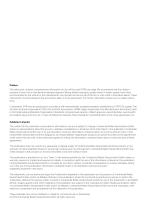
Preface This data book contains comprehensive information on our off-the-road (OTR) tire range. We recommend that the inflation pressure of every tire is checked and adjusted regularly. Wrong inflation pressure, greater loads or higher speeds than those recommended by the vehicle or tire manufacturer may shorten the service life of the tire or may result in premature failure. These instructions must be followed if tire and vehicle safety is to be guaranteed. For further information, please see our safety instructions. Continental’s OTR tires are produced in accordance with internationally...
Open the catalog to page 2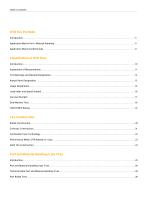
Technical Data Port and Material Handling Tires____ Port Radial Tires
Open the catalog to page 3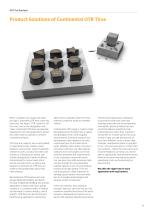
When conditions are rough and loads are high, Continental OTR tires come into their own. The letters "OTR” stand for "off the road”, and as this designation indicates, Continental OTR tires are specially designed for off-road applications, where they often have to operate on uneven, unfinished surfaces. OTR tires are made for use on articulated or rigid dump trucks, loaders, reach stackers, various other types of specialty vehicles in ports, construction sites, and surface or underground mining. Specifically developed for harsh conditions characterized by heavy loads, sharp stones, and hard...
Open the catalog to page 5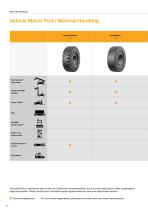
The vehicle/tire combination above refers to Continental recommendation, but in certain applications, other combinations might be possible. Please consult your Continental sales representative for your own tailor-made solution. Preferred application For use in other applications, please get in contact with your sales representative
Open the catalog to page 6
Vehicle Matrix Earthmoving EM-Master E3/L3 Radial Articulated Dump Truck Rigid Dump Truck (RDT) RDT-Master Radial DumperMaster Radial Underground Dump Truck Underground Loader (Scoop) Support Machine Coal Haulers Shuttle Car b Application possible, please contact your sales representative.
Open the catalog to page 8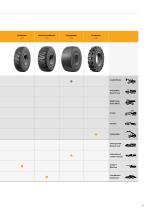
DrillMaster V.ply UndergroundMaster V.ply ScoopMaster V.ply TeleMaster Solid Articulated Dump Truck Rigid Dump Truck (RDT) Underground Dump Truck Underground Loader (Scoop) Support Machine Coal Haulers Shuttle Car
Open the catalog to page 9
Introduction The off-the-road business is characterized by a huge variety of different machines ranging from reachstackers in port application to dump trucks running in the deepest underground mines. This diversity calls for specialized tires that differ in construction, tread design and compounds as well as other characteristics. The tire industry has developed different classifications in order to make it easier to identify the right tire for the right application. The following pages give an overview of the most common classification/designation types for OTR tires.
Open the catalog to page 10
Explanation of Tire Measurements Bmax. Tire section height Rim diameter Static loaded radius Maximum operational width Cross section width Max tire outer diameter in service Tire outer diameter Radial deflection The dimensional data given in this data book and in the following tables complies with ETRTO standards where applicable. Additional information, such as additional tire sizes not listed in ETRTO, are provided in compliance with DIN or WdK guidelines. All data is correct at date of publication but is subject to change and cannot be guaranteed. Note: The in-service diameter is the...
Open the catalog to page 11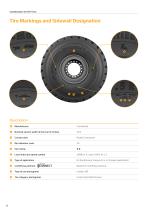
Tire Markings and Sidewall Designation Nominal section width of the tire (in inches) 29.5 Star rating Load index and speed symbol E3 (Earthmover transport) or L3 (Loader application) Manufacturer Continental Tire category (pictogram) Construction/Earthmover Radial Constuction
Open the catalog to page 12
Off-the-road tires are labeled for size in one or more ways. Each size marking contains important information about the dimensions and capacity of the tire. The chart below lists the different types of size designations you may see stamped on an OTR tire sidewall along with what they mean. Please note that the table below lists the most common aspect ratio designations for OTR tires but doesn't necessarily show all designations listed in ETRTO or other technical tire and rim organizations. 70' or 75' series tires follow the same approach as for the the 65' series tires.
Open the catalog to page 13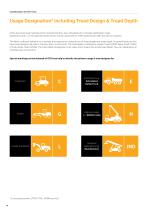
Usage Designation* including Tread Design & Tread Depth Some tires have dual-markings which indicate that they were developed for a broader application range (example: E and L on the sidewall means the tire can be used both for OTR machines like ADTs but also for loaders). The letter codes are followed by a number that represents a special kind of tread design and tread depth. In general there are five basic tread designs: Rib, Block, Traction, Rock, and Smooth. The tread depth is defined as regular tread (100%) Deep Tread (150%) or Extra Deep Tread (250%). The tread depth designation is an...
Open the catalog to page 14
Regular Tread Deep Tread 250% -5 Extra Deep Tread The combination of the letters and numbers is often called TRA- or EM-Code and is an international classification system for OTR tires. The following table gives a rough overview of the different combinations. TRA Classification/ EM-Code*
Open the catalog to page 15
The maximum load which can be carried by a tire is indicated by the Load Index (LI). This tire LI is always related to a specific reference speed which is indicated by the Speed Symbol. In addition to the reference speed other application conditions can be specified by the tire manufacturer. It is important to understand that changing service conditions and/or different vehicle speeds may impact the load-carrying capacity of the tire.
Open the catalog to page 16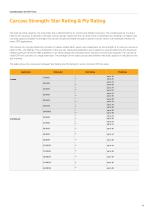
The load-carrying capacity of a pneumatic tire is determined by air volume and inflation pressure. The compressed air in a tire is held by the caracass. In general a stronger carcass design means the tire can hold more compressed air, resulting in a higher load carrying capacity. Despite its strength, the carcass should be flexible enough to absorb shocks, which is an essential criterion for many OTR applications. The carcass of cross-ply (bias) tires consists of rubber-coated fabric layers, also called plies, so the strength of a Cross-ply carcass is rated in PRs - Ply Ratings. The...
Open the catalog to page 17All Continental Tires catalogs and technical brochures
-
ContiRV20 All Season
2 Pages
-
OTR
48 Pages
-
Port
17 Pages
-
Tubeless Sealing Ring
6 Pages
-
Enhanced by expertise
17 Pages
-
Industrial Pneumatic Tires
20 Pages
-
Continental Solid Tires
24 Pages
-
Continental Earthmover Tires
28 Pages















